In Reaping the Rewards, I take a look at the final product from a crowdfunding campaign. Today’s topic: Heroes of Land, Air & Sea, which was successfully funded on Kickstarter in June 2017 (after an initial attempt in February). The game is printed and is on its way to fulfillment centers now, with expected delivery to backers in February 2018. Gamelyn Games sent me an advance copy to try out, so let’s dive in!
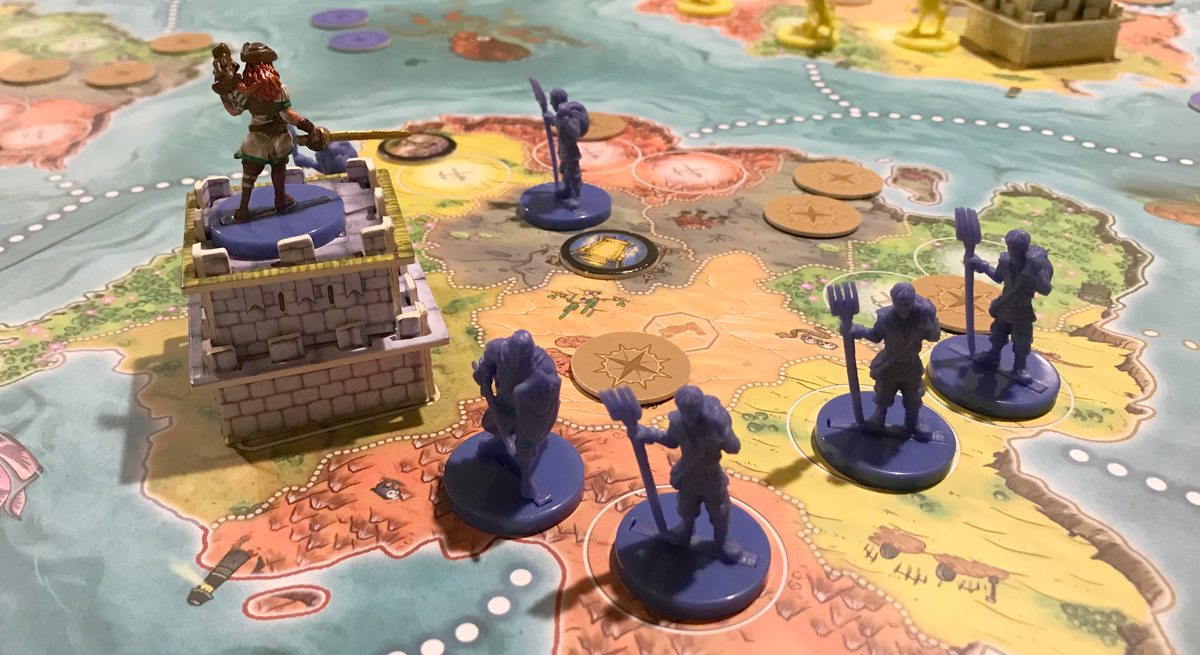
What Is Heroes of Land, Air & Sea?
Heroes of Land, Air & Sea is a 4X fantasy game for 1 to 4 players (up to 6 with expansion), ages 14 and up, and takes about 30 minutes per player. It is currently available for pre-order from Gamelyn Games; the core game retails for $99 and the expansion is $79.
I would say the game’s rules are not extremely difficult—there are just a lot of them—so the game may be okay for slightly younger players if they’re experienced; primarily they need to have the patience and attention for a longer game. The game is set in a fantasy world and includes warfare, but does not have anything particularly inappropriate for kids otherwise. I’ve played with my 11-year-old and 13-year-old daughters, who both enjoy the game.
Heroes of Land, Air & Sea is GeekDad Approved!
Heroes of Land, Air & Sea Components
Our web wizard tells me that the vast majority of GeekDad readers visit our site on mobile devices. Well, if that’s you, get thee to a bigger screen! Heroes of Land, Air & Sea is a massive game with tons of components, and viewing it on a tiny screen just won’t do it justice.

Here’s what comes in the huge core game box:
- Game board
- First Player token
- 3 Resource tokens for Tax action
- 94 Exploration tokens (70 Land, 24 Sea)
- 60 Spell cards
- 4 sets of Faction components (Humans, Orcs, Dwarves, Elves):
- 3 Heroes
- 5 Warriors
- 12 Serfs
- 3-part Capital City
- 3 Towers
- 1 Sea Vessel
- 1 Air Vessel
- 1 Air Vessel stand
- 1 Faction board
- 3 Resource tokens (Food, Magic, Ore)
- 3 Hero cards
- 7 Tactics cards
- 2 Action tokens
- 1 scoring token
- 8 Solo Enemy cards

And here’s what comes in the Order & Chaos expansion box. (Order & Chaos expands the game to 6 players and adds 4 new factions; it is not a stand-alone game and will require some of the shared components from the core box.)
- Game board
- 2 sets of Resource tokens (Food, Magic, Ore)
- 2 Air Vessel stands
- 4 sets of Faction components (Lionkin, Lizardfolk, Goblins, Undead):
- 3 Heroes
- 5 Warriors
- 12 Serfs
- 3-part Capital City
- 3 Towers
- 1 Sea Vessel
- 1 Air Vessel
- 1 Faction board
- 3 Hero cards
- 7 Tactics cards
- 2 Action tokens
- 1 scoring token
- Undead Underworld card
- 6 Soul tokens
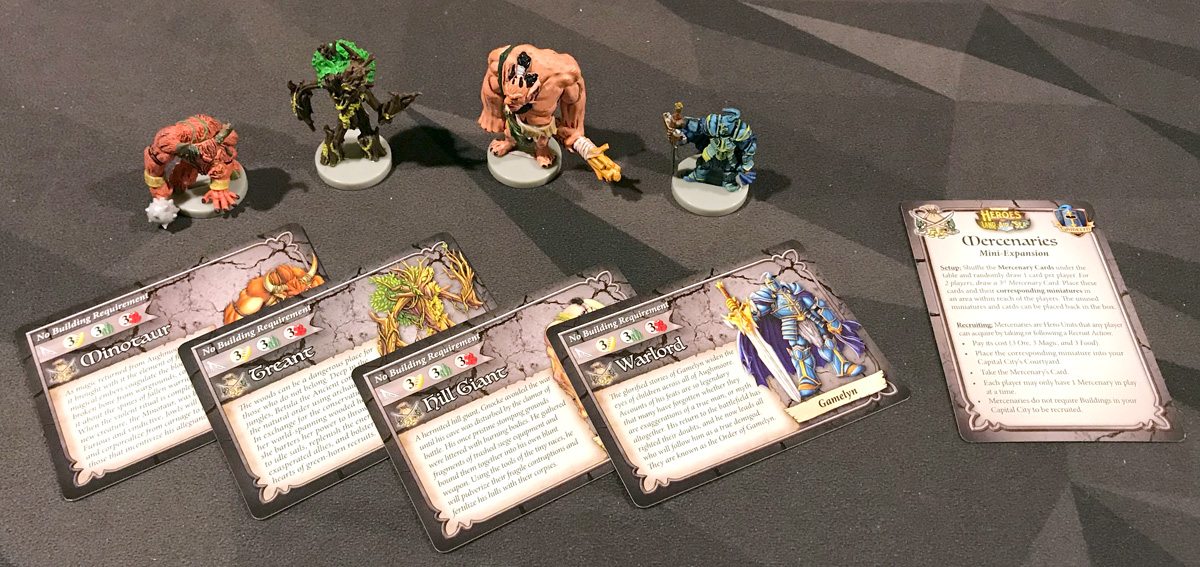
Kickstarter Exclusives and Add-Ons
My copy includes a few things that won’t be in the retail edition: the hero miniatures are painted, which was an available add-on for the Kickstarter and is not available anymore.
I also have some of the mini-expansions, which were included for Kickstarter backers and will be available for order from Gamelyn Games: Mercenaries #1 ($15), Mercenaries #2 ($10), Nomads ($20), and Siege Engines ($10).


Other add-ons include the sleeve set ($15), which has foil-backed card sleeves that have each of the card backs printed on them. (There are also some clear sleeves for the hero cards, which are double-sided.) Finally, I received the optional neoprene playmat ($40), which can replace the 5-6 player board—you’ll see plenty of photos of that below.
I’m using the sleeves and the playmat extensively throughout this review, but will save the mini-expansions for a separate review.

Cardboard Constructs
The first thing you’ll need to do before you can play Heroes of Land, Air & Sea is assemble all the constructs. Punch, fold, slot, tape all that cardboard, and then you’ll end up with a set of buildings (a three-tiered capital city and three octagonal towers) and vessels (sea and air) for each faction.
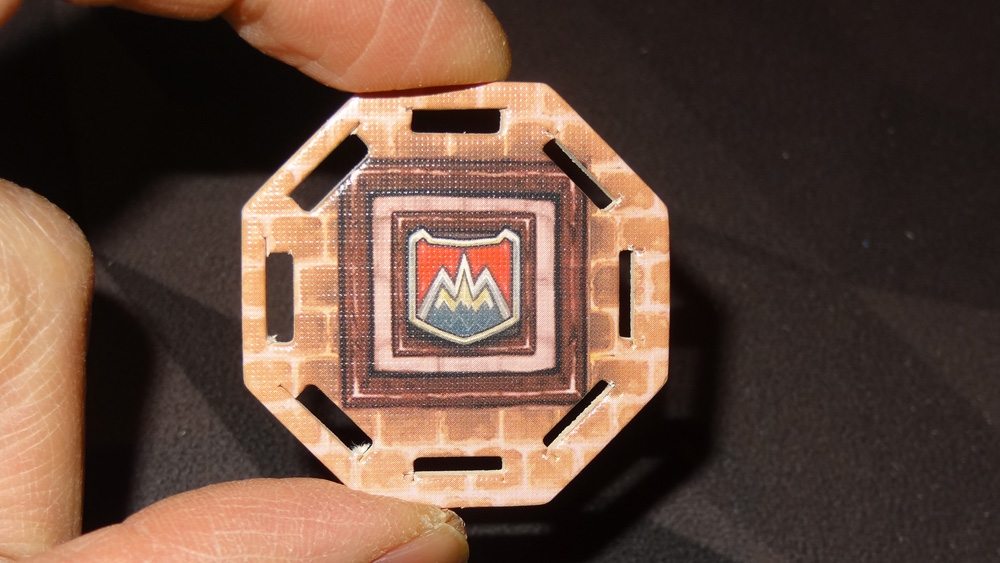
For the most part, everything assembled very easily, but I did have a little trouble with the Dwarf towers in particular: some of the slots were too narrow, and I ended up cutting them wider with an X-acto knife so that the tabs didn’t get bent up. My daughter (who happens to love papercraft) and I spent about an hour assembling all the constructs from the core set, and then she put together all the pieces from the expansion on her own without any further difficulties. If you like papercraft, it makes for a fun little activity. (If not, well, put your kid to work!)


Once assembled, they look really great. Some of the printed graphics aren’t perfectly aligned with the cut-out shapes (like windows that should be centered on a wall) but you don’t really notice that unless you’re inspecting them closely. Each faction has its own logo, which appears on its buildings–the towers and capital cities all have the same structure, just with different illustrations on them.
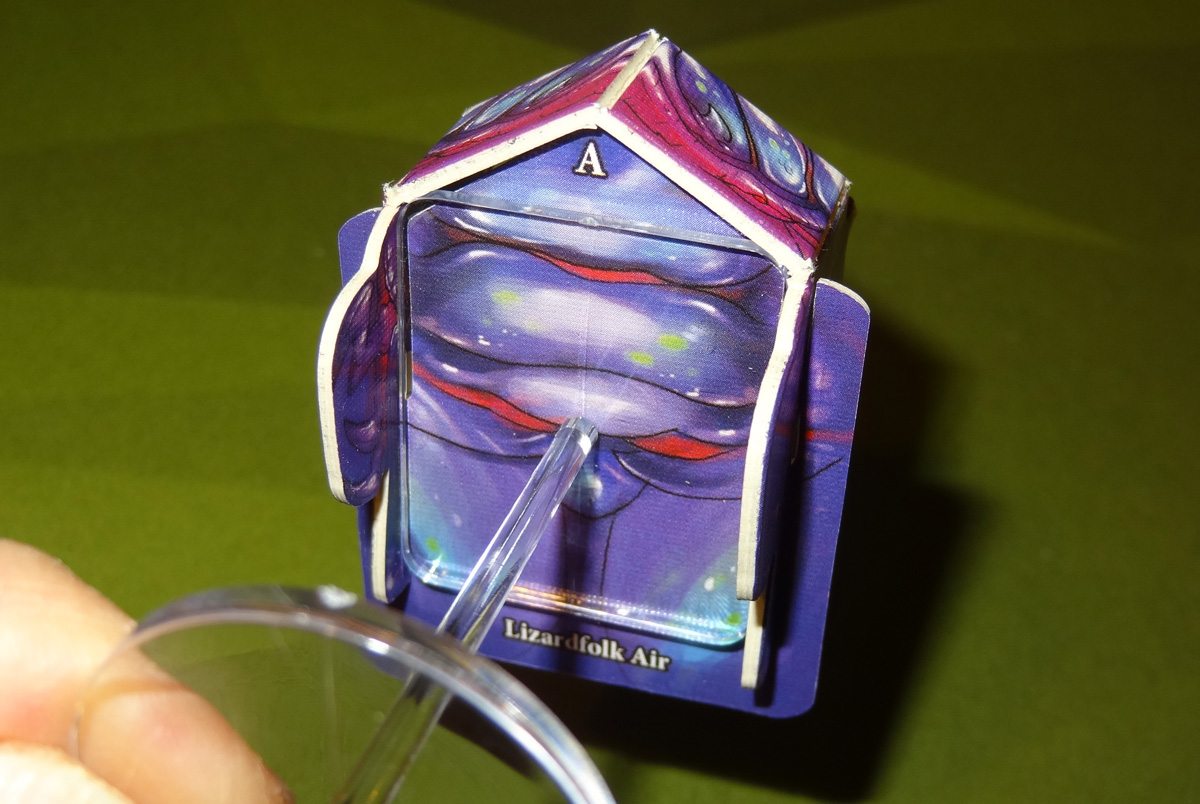
The sea and air vessels have a little more variety: the orcs fly on a dragon, while the elves have a phoenix. The boats are also slightly different from each other, with a few that stand out, like the orcs’ crocodile or the goblin submarine. The air vessels slide onto clear plastic stands so that they look like they’re hovering above the board.
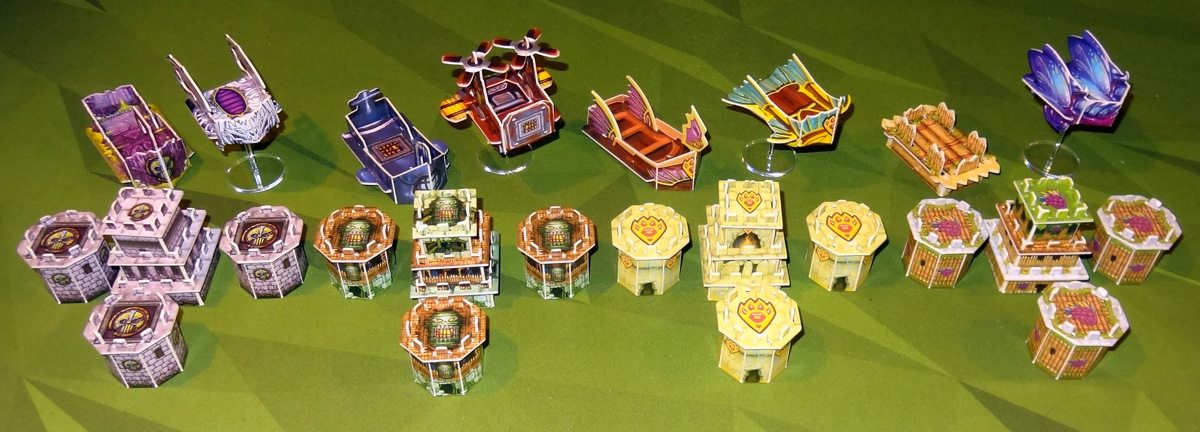
Plastic Miniatures
There are a whole lot of plastic miniatures, too: each player gets serfs, warriors, and three unique heroes. The models are pretty nice: you can tell just by the models which ones are serfs and which are warriors, because of what they’re carrying and how they stand. (And they match the illustrations on the faction boards.) Since they’re all unpainted, though, it can sometimes be a little tricky to distinguish them from a distance.

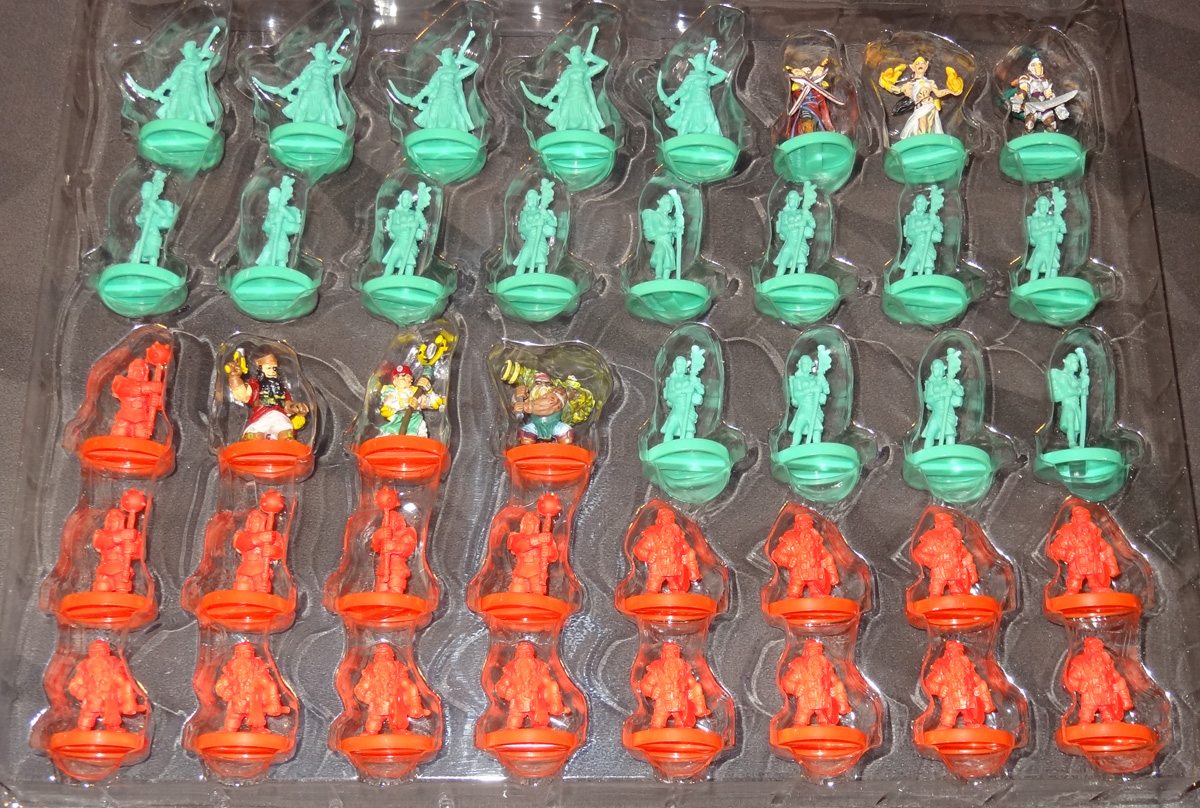
There are three different heroes for each faction, and these have unique models that are easier to distinguish–particularly if you splurged for the painted versions (or paint them yourself). I’d say that the paint job is passable–certainly better than what I could do myself, but not as good as the stuff my friends paint. It definitely helps the heroes stand out from the serfs and warriors. Each faction’s miniatures are a different color plastic (matching the faction’s action tokens and scoring token), making them easy to distinguish at a glance.
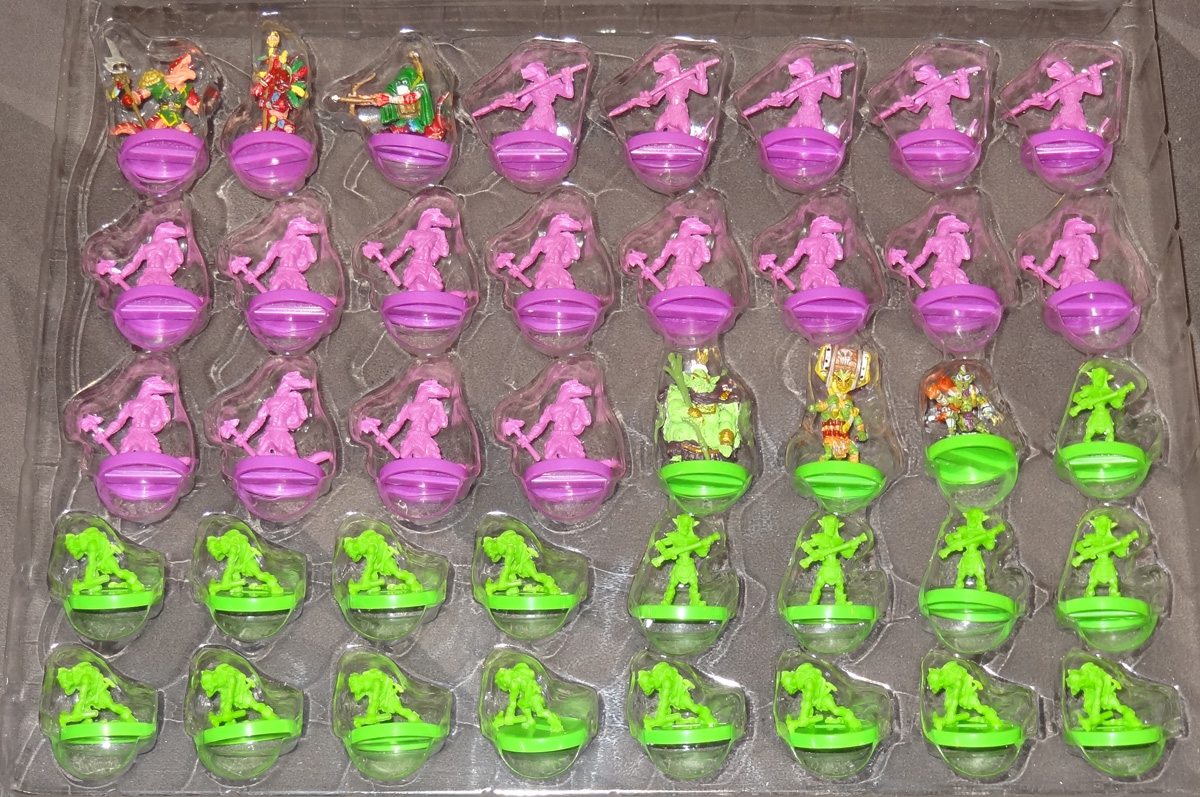
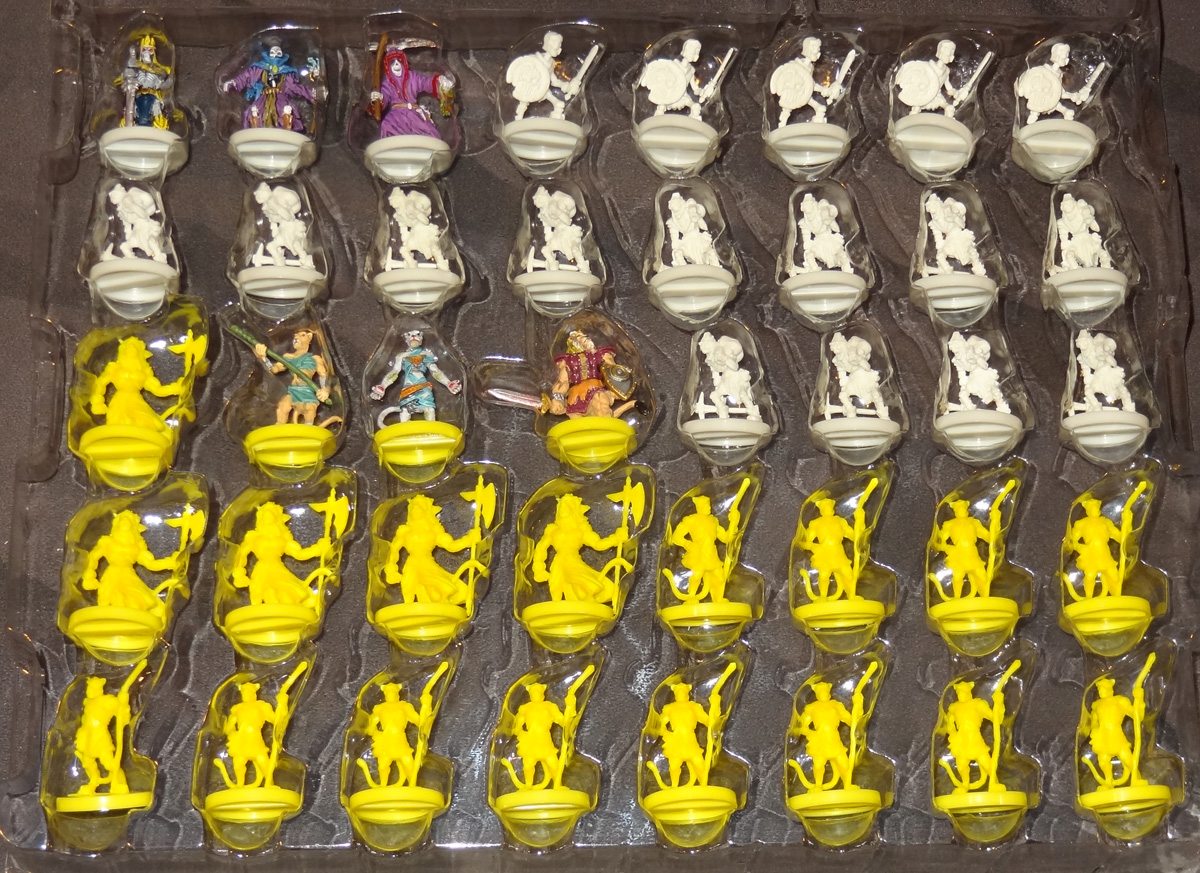
Faction Boards
The faction boards are 9″x11.5″ and have a lot of information on them. They represent your capital city, with a courtyard and five buildings that can be built to expand your abilities. Across the top are several action banners, and then there are various costs and point values for buildings and units. At the right side are three spaces for scribed spells to be placed next to the board. Each of the buildings also has a little illustration at the top of its column. I like the way each faction has its own names for its buildings and heroes, though everyone has a fighter type, a mage type, and a rogue type of hero. (I will mention that the Lizardfolk in particular, with their voodoo hut and witch doctor, seem like a bit of tribal exoticism, though that hasn’t stopped me from trying them out as a player.)
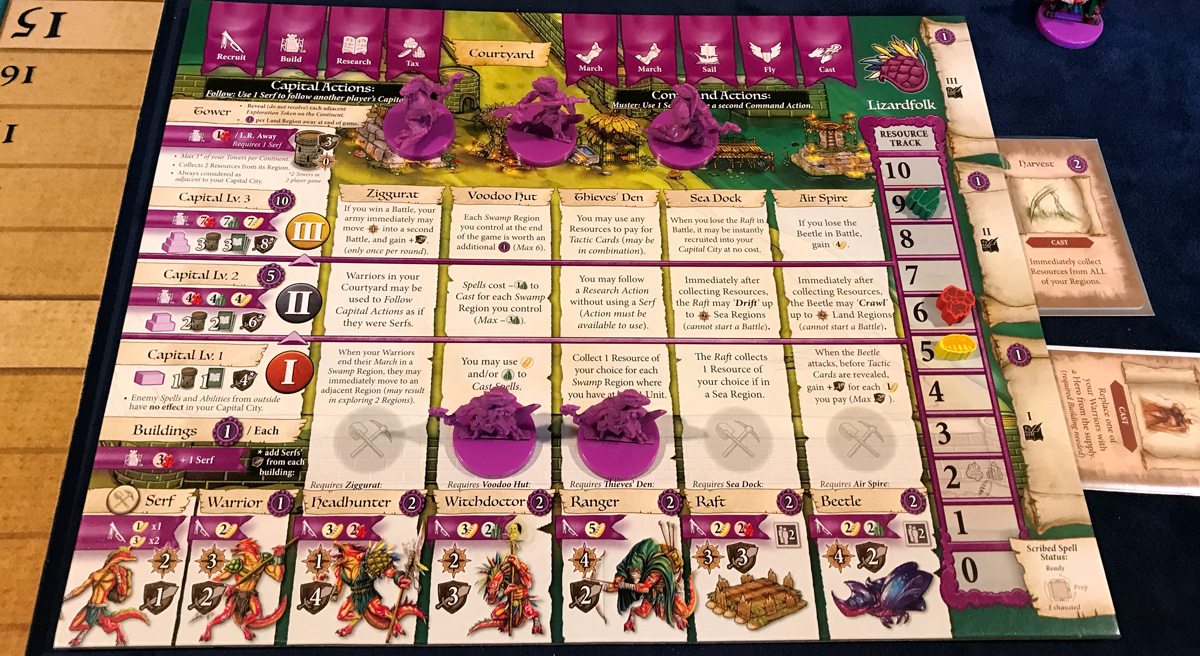
There’s a lot of information packed onto the faction boards. Everything has a listed cost to build or recruit, an attack/defense strength, and point value, but the first time you see the board it can be a bit overwhelming and new players often miss things like the cost of the buildings (listed just above the Serf and Warrior). And, of course, you’ll have fifteen different building powers (5 buildings, 3 tiers of powers each) to study for each faction.

The Map
The map board is based on a 13″ square, which is the footprint of the game box. The core game’s board has four continents and opens to 26″x26″. The expansion board adds two more continents, expanding the world to 26″x39″. The playmat is even larger, at 3’x4′. Each section of the board has a continent made up of various terrain types, with a space for a capital city and many circles where serfs can be placed. The artwork has lots of little details aside from the terrain, so you’ll spot unicorns hiding in the forest or buildings from the various factions scattered around. Between the miniatures and the board, Heroes of Land, Air & Sea is really colorful and eye-popping when you’re playing a game.
A note about the playmat: it depicts the board for 5 or 6 players. The ferry routes are slightly different than the board for 1 to 4 players, so if you have fewer than 5 players, technically you shouldn’t use the mat. We’ve been using it anyway, and I just indicate to the players what the differences are.
The original map shown in the Kickstarter campaign had more odd-shaped continents that weren’t confined to squares. I can see from a game standpoint (particularly in having the add-on expanded board) why the square-ish continents were used, but personally, I liked the look of the prototype map a little better. Each continent is a little more balanced now.
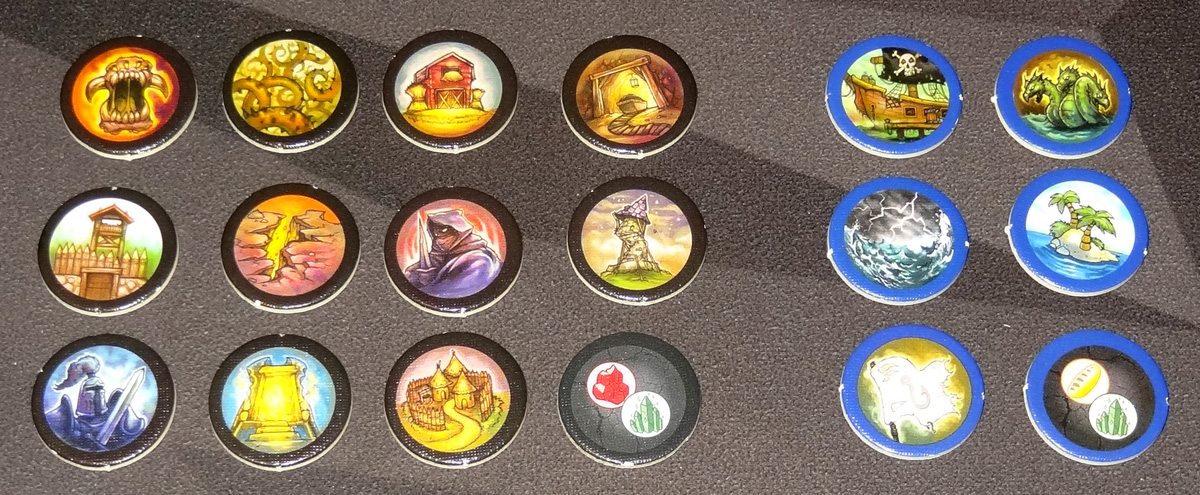
The exploration tokens are placed all over the map during setup and are revealed as you explore land and sea spaces. They just have little illustrations on them, and you check a reference sheet to see what they do–the reference sheet even has a little short bit of flavor text accompanying each token type, giving it a little more story. The downside is that, until you learn to recognize the tokens, you have to keep referring to the sheet, because they don’t use any sort of game iconography. I think it might have been nice to add icons to some of the tokens, like the forts that provide +1 defense or the villages that give you 2 bonus points at the end of the game.
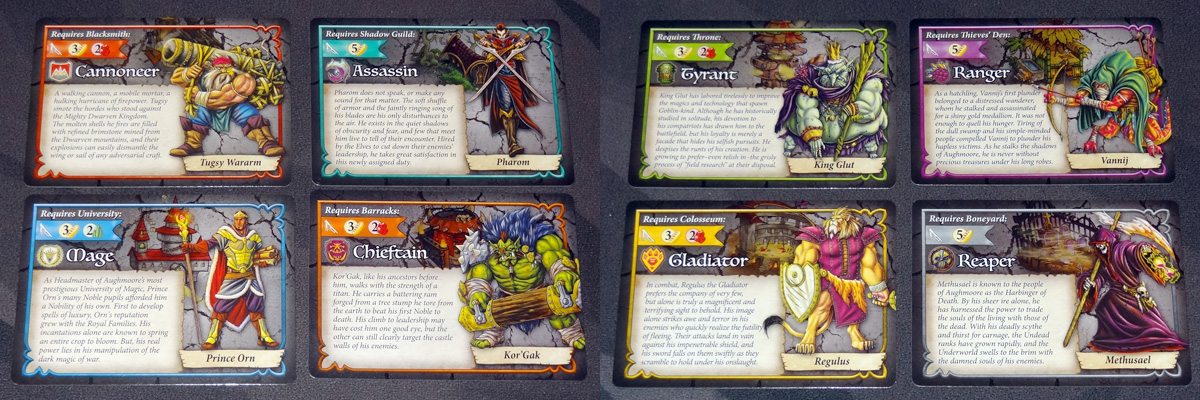
The Lore of Aughmoore
Speaking of flavor text, there is a lot of lore about the world of Aughmoore, written by Jacob M. Burton, Dylan D. Phillips, and Michael Coe. The core set and expansion each have a full page devoted to the background story on how these wars started and a little bit of how the various factions are involved. At the back, there is also a section on each faction, sort of an origin story of the faction. Each of the hero cards also has a story on the back. Finally, there’s a short victory lore paragraph for each faction: when you win, you get to read the story of what happens after your faction controls Aughmoore. If you like your games to have a narrative, you’ll enjoy reading up about your faction and your heroes before you play. I did notice a few typos here and there—not a lot, considering the sheer amount of text, but sometimes noticeable.

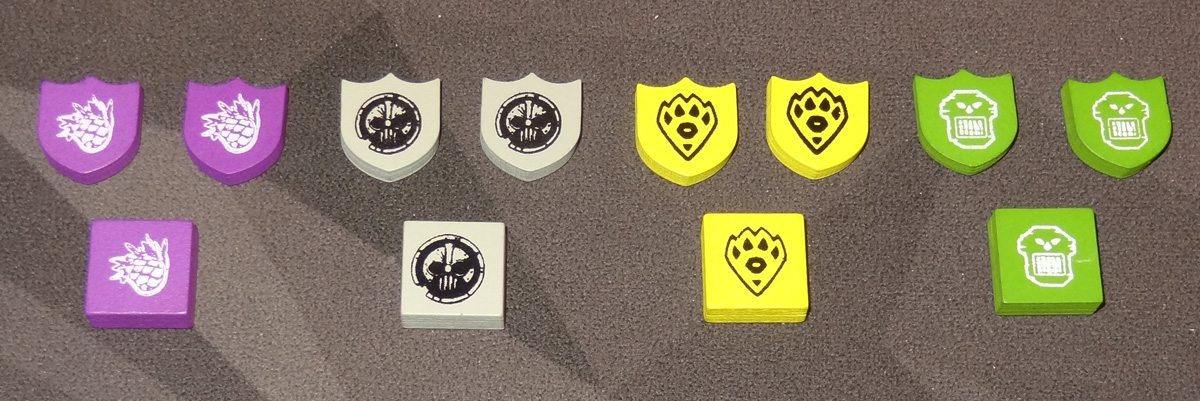
Other Components
Other components are nicely done: the action tokens and scoring tokens are wooden, painted to match the miniatures and screenprinted with the faction logos. The resource tokens are small wooden tokens, also screenprinted on one side. They’re the only thing about the game that’s tiny–but it can be hard to put all three of them in the same space on the resource track, which is fairly small as well.
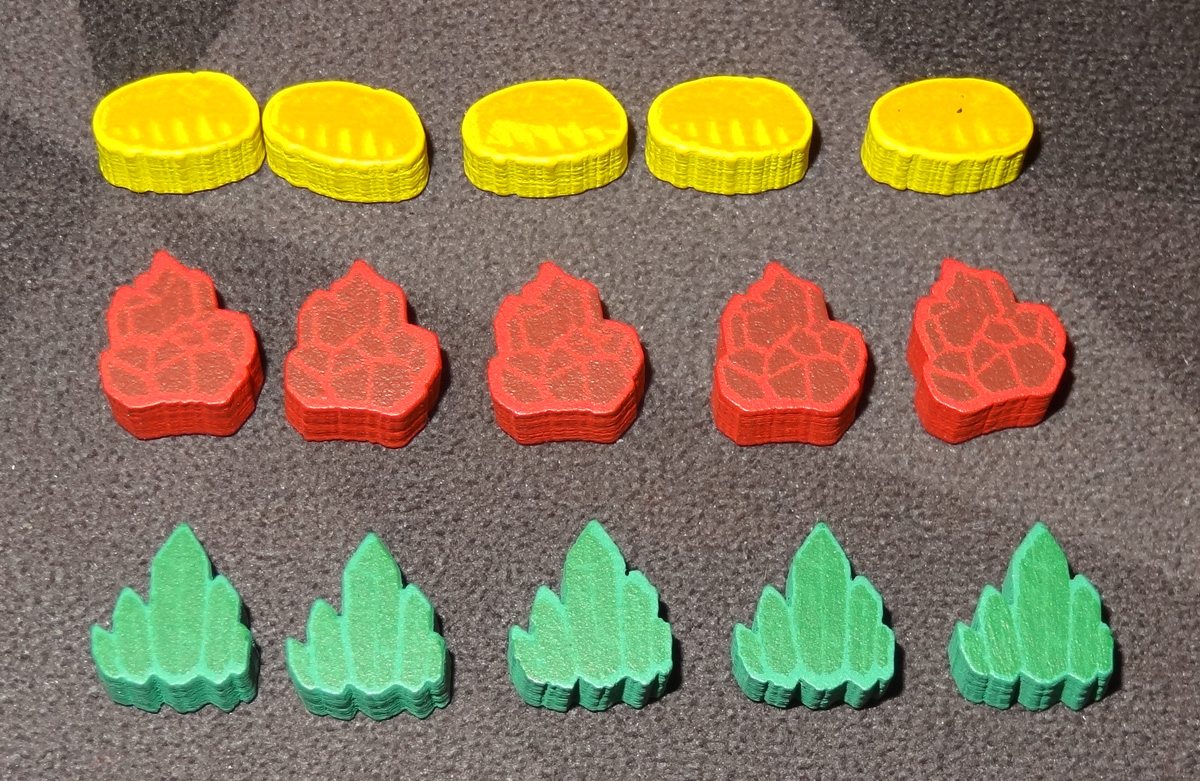
Tactics cards and hero cards are standard-sized cards, and spell cards are half-sized cards.
There is a lot of text in this game–on the faction boards and on the cards–and a lot of it is fairly small text, so if you have trouble with small text it may be a little harder to play until you’re familiar enough with a faction’s powers that you don’t need to refer to the text anymore.
Storage
These boxes are large. Although there’s no universal standard, a lot of the game boxes on your shelf are probably about 12″ square and 3″ tall, give or take. Heroes of Land, Air & Sea is 13.5″ square, and 5″ tall. That extra height is necessary, though, because once you put all the cardboard constructs together they take up more space.
The miniatures come in plastic trays that have some additional wells for cards and other components. Some of the wells have dividers for cards, and some don’t. Since the miniatures vary in shape, you have to put all of them in the right places to make them fit. After the first time my kids got out all the miniatures at once and I had to figure out where they went, I labeled the trays with a Sharpie to make it easier to find the right sections for each faction.
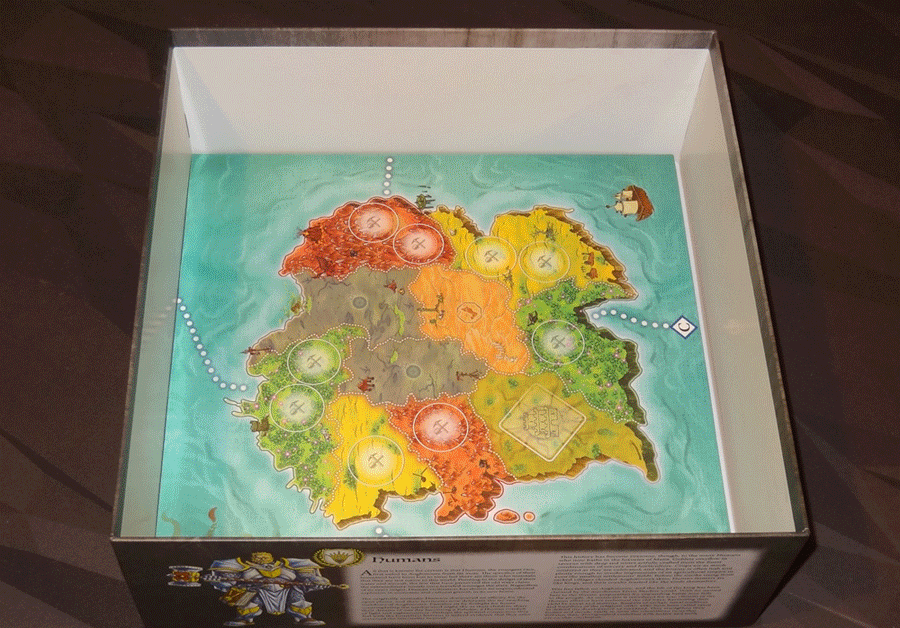
Here’s how I stack the components, from bottom to top: game board, faction boards, two trays of miniatures, rulebook, and then the constructs. There’s a plastic lid that goes over the miniatures trays, but I actually turned it upside down, laid it on top, and then put the constructs on top. That way, I can lift out the whole tray without spilling constructs everywhere. Even with the extra headroom in the box, there are a few of the taller constructs (like the sea vessels that have prows) that barely fit. And because of the weight of the map board and faction boards, I would recommend storing these flat—I worry that if you turn the box upright (or flip it over to look at the box bottom), it would crush the constructs.
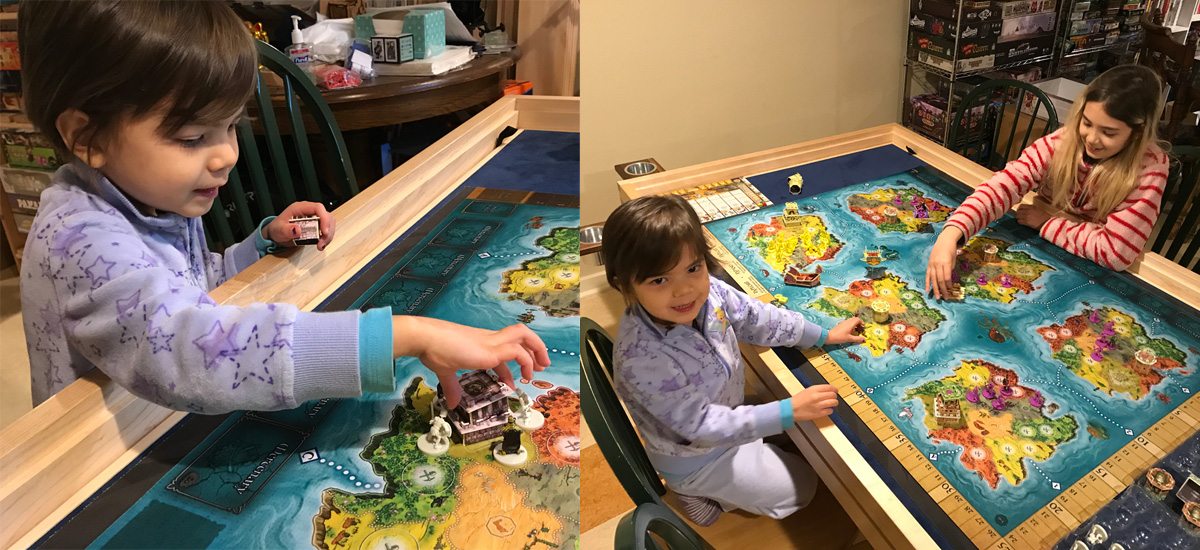
Toy Factor
Even aside from the gameplay itself, Heroes of Land, Air & Sea has a great toy factor. My four-year-old loves setting up cities and towers and miniatures on the map when we aren’t playing, and will tell elaborate stories about what’s going on. She’s even gotten adept at putting all of the miniatures back into their spaces in the trays afterward. Of course, I wouldn’t recommend buying it just as a playset for a toddler, but if you have younger kids (that you trust with your games) you might get some bonus use out of them.

How to Play Heroes of Land, Air & Sea
Heroes of Land, Air & Sea is a 4X game, a genre named after four Xs: Explore, Expand, Exploit, Exterminate. Generally, these type of games include exploration on a map of some sort, increasing your population (or army, or fleet, etc.), building up your technology and abilities, and attacking other players. Both Tiny Epic Kingdoms and Tiny Epic Galaxies (also by Scott Almes and Gamelyn Games) were also 4X games, though with different styles of play and, of course, much tinier. Heroes of Land, Air & Sea is most similar to Tiny Epic Kingdoms in terms of the fantasy theme and some shared concepts, though it is not simply a larger version of the game.
The Goal
The goal of Heroes of Land, Air & Sea is to have the most points at the end of the game, which is triggered when one of the four Xs has been “completed.” (More on that later.) You score points for various things: controlling territories; recruiting units; building towers, your capital city, and buildings; winning combats and casting spells during the game; and a few other methods.
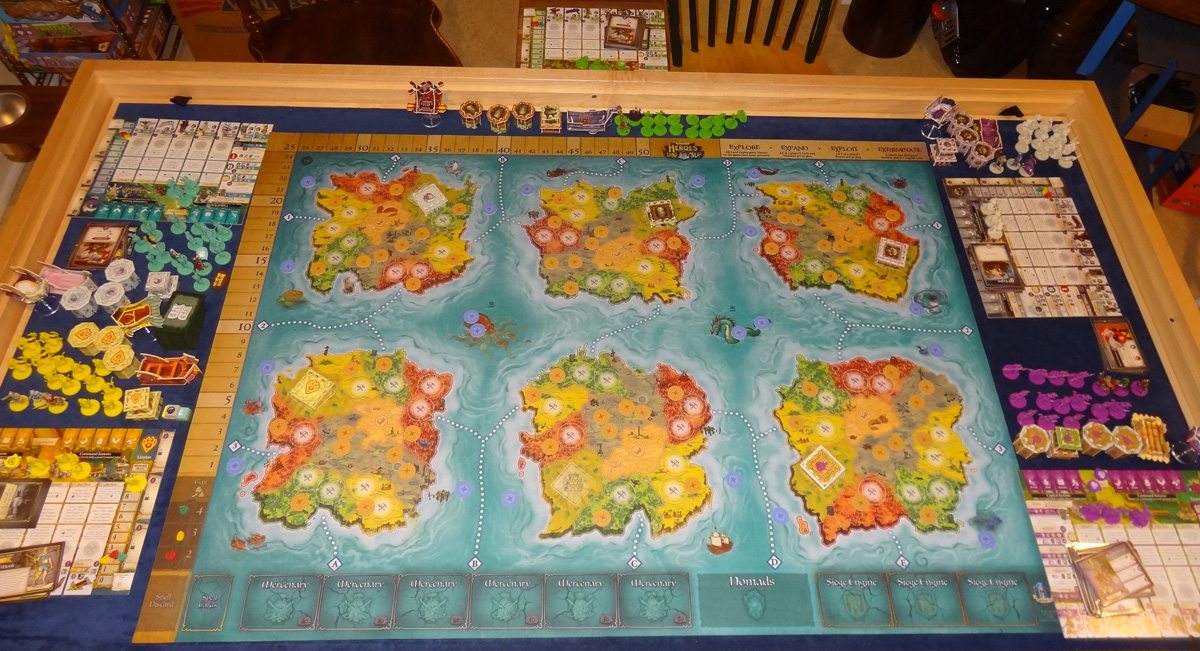
Setup
You’ll start with the big map in the center of the table—the number of continents used in the game is based on the number of players. The land and sea regions will have random exploration tokens (of the corresponding type) placed face-down on them. Swamps have two tokens, as do the large center ocean spaces; capital city regions (marked with a large square with a castle icon) do not have any tokens. Take three resource tokens (mana, ore, food) and randomly order them in the Tax section on the corner of the map board. Shuffle the spell cards and set the deck aside. Choose a first player and give them the first player token.

Each player chooses a faction and gets all of the associated components: a board, all of their miniatures and constructs, two shield-shaped action tokens, their hero cards, a set of tactics cards, and the three resource tokens. In addition, they draw one spell card from the deck. The scoring tokens are placed near the start of the scoring track. The resource tokens are all placed on “2” on the faction board, and each player puts 2 serfs and 1 warrior in their courtyard on their faction board. The level 1 base of their capital city is placed on the map.
Gameplay
The game takes place over many rounds. During a round, each player in turn order will choose an action, and then each player will choose a second action. After the actions are resolved, everyone collects resources, draws a spell card and refreshes scribed spells, and the first player marker is passed.
There are two types of actions, printed across the top of the faction board: capital actions are on the left side and can be followed by other players; command actions are printed on the right side and can be mustered (so that you take two command actions in a single turn). To choose an action on your turn, place one of your action tokens on that action on your faction board; you may only take an action if that space is not already occupied.
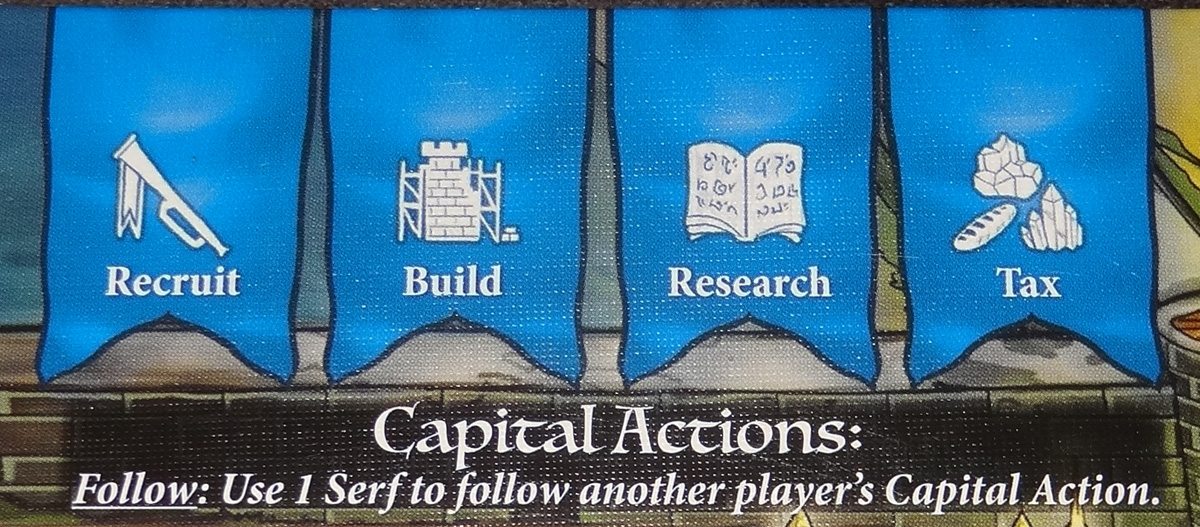
Capital Actions
When a player chooses a command action, other players may “follow” that action, if that action is still available on their board and they have an available serf in their courtyard. They place the serf on that action space on their own faction board, and then take the action simultaneously.

Recruit: Pay costs to recruit units from your supply, placing them in the courtyard on your board. At the beginning of the game, you can only recruit serfs and warriors; in order to recruit heroes or vessels, you must have built the associated building in your city.
Build: Pay costs to build a building, a tower, or your capital city.

- Buildings: You have five different buildings in your capital city—each provides bonus abilities and allows you to recruit a specific hero or vessel. Each building has three abilities, and they’re unlocked automatically as you upgrade your capital city. To build a building, you must have an available serf, which is then placed on the building spot of your faction board to indicate that it’s been built, and you spend 3 ore. (The serf remains there for the rest of the game.)

- Towers: Towers are worth points, help defend a territory in battle, and help you collect resources. The further they are from your capital city, the more they cost, and the more points they’re worth. They’re also considered adjacent to your courtyard, so you can deploy units directly into faraway regions with towers. Finally, when you build a tower, you also reveal (but don’t resolve) all of the exploration tokens adjacent to it on that continent. You may only build a tower in a region that has one of your serfs in it, and only one per continent. Each tower costs 1 ore per space away from your capital city.
- Capital city: Your capital city’s level (from 1 to 3) indicates how many spell cards you can hold in your hand, how many spell cards you can scribe, how much defense your city has, and how many points it’s worth. In addition, each time you upgrade your city, you also upgrade the abilities of all of the buildings you have built, as well as any heroes and vessels you have recruited. Level 2 costs 4 ore, 4 mana, and 4 food. Level 3 costs 7 ore, 7 mana, and 7 food.
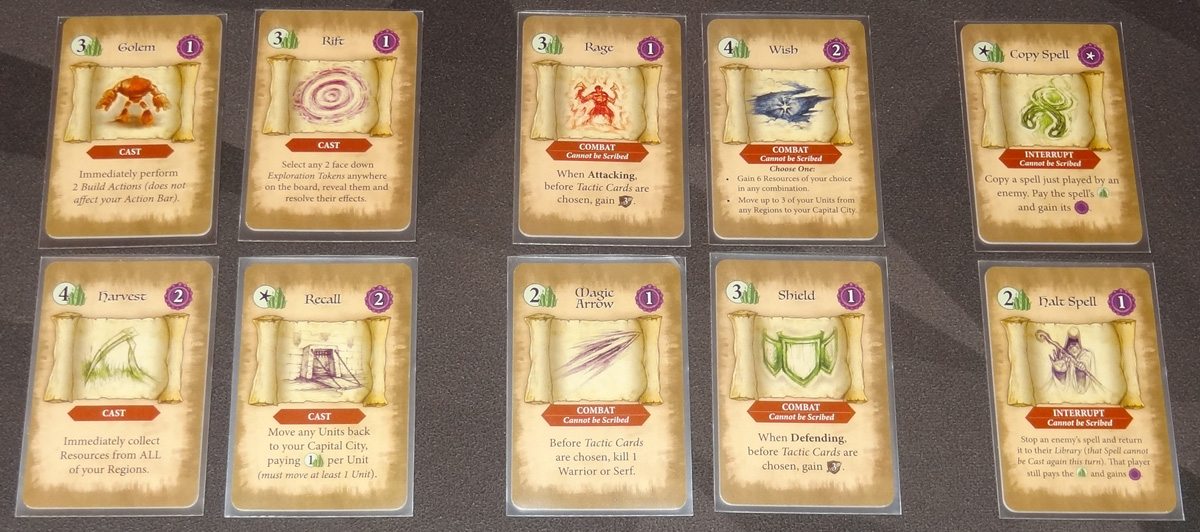
Research: Draw three spell cards and then discard down to your hand size, or scribe a spell. To scribe a spell, you place it face-up on the right edge of your faction board. Scribed spells may be cast again after a recharge period, whereas spells cast from your hand are discarded. Note that combat spells and interrupt spells may not be scribed (as noted on the cards).

Tax: On the main board, there’s a tax section showing three resource icons at values 2, 3, and 4. You may choose one of those resources and then gain the indicated amount. Then, rotate the tax section so the 4-value resource drops to 2.

Command Actions
After you take a command action, you may muster by placing an available serf from your courtyard onto another available command action. You may only muster once per turn, and you may not muster a capital action.
March: Move a group of up to 5 units across land (and ferry routes)—the number of spaces you may move is indicated by the slowest unit in the group, indicated by the compass rose icon at the bottom of your player board. If you encounter an opponent, your movement ends and you must initiate a battle. Otherwise, when you end movement, you reveal and resolve any exploration tokens in that space. There are two march actions on the faction board so you can take this action twice in a round. You have to stop in desert spaces even if you have movement left. There’s a 5-unit-per-player limit for each terrain space.

Sail: Move your sea vessel equal to its speed. Sea vessels can carry two units with them if desired, will initiate battle if encountering other sea vessels at sea, and will reveal exploration tokens when they stop movement. The center sea space, like the desert, ends your movement and you must take another sail action to leave. Docking and undocking from a shore space uses 1 speed; while docked to a shore, you may move units freely between the boat and that region without spending any actions.
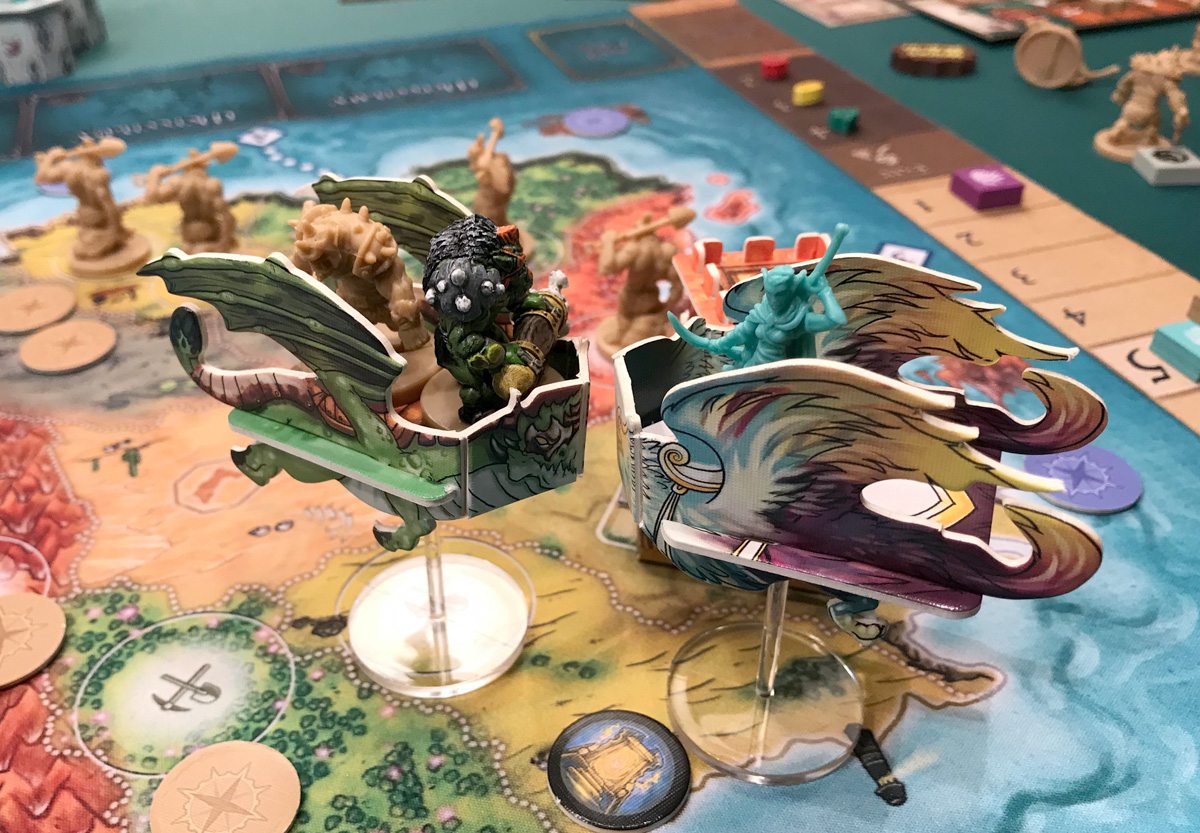
Fly: Move your air vessel equal to its speed. Like sea vessels, air vessels may also carry two units, and will also initiate battle. Air vessels travel on land spaces and sea spaces; the center sea space uses 2 speed to fly through. You must end your movement on land. If you fly into a sea space and initiate a battle, you have 1 more speed after the battle (if it survives) to get to land.
Cast: Cast a spell from your hand (your “spell library”) or one of your ready scribed spells by paying its mana cost and then taking its effect. You also gain points on the scoring track when casting a spell. If you cast a scribed spell, rotate it 180°. There are three types of spells: cast, combat, and interrupt. The “Cast” action may only be used for “cast” type spells. Interrupt spells may be cast immediately after a player uses a cast spell. Combat spells are only played during combat.
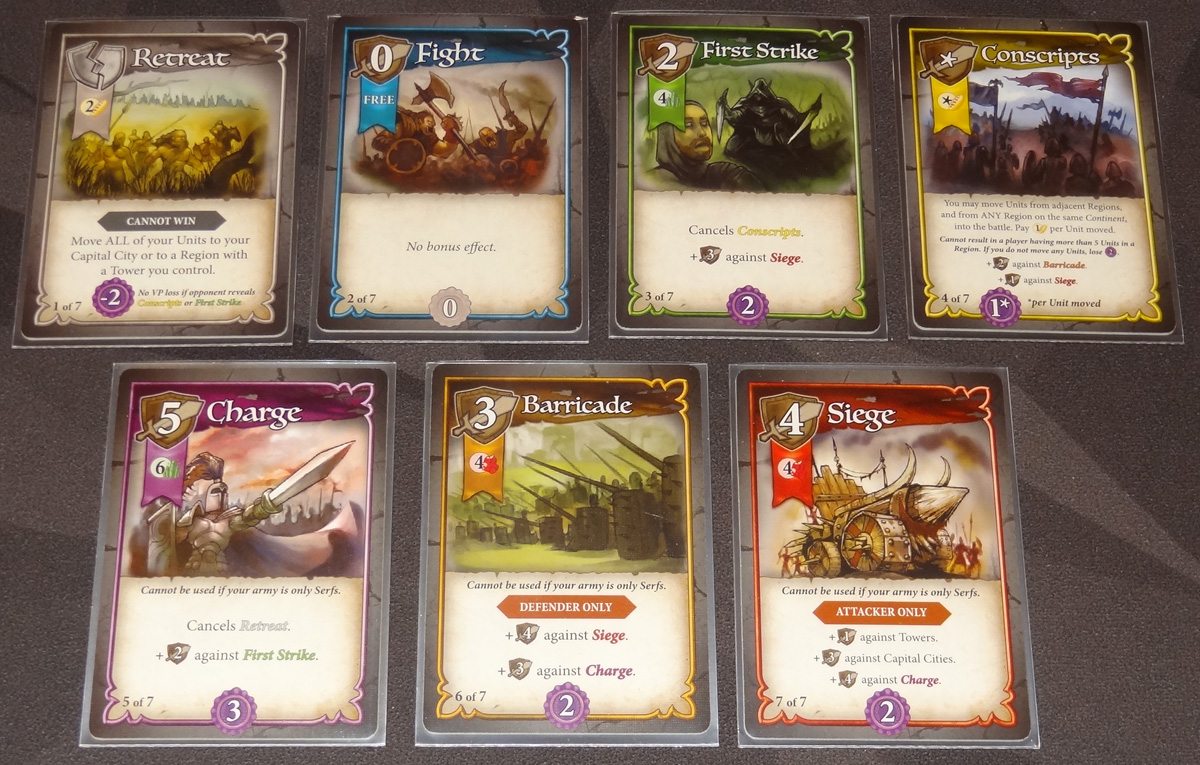
Combat
Battles take place whenever you end your movement in an enemy space. The attacking player scores 1 point just for picking a fight. First, the defending player may play a combat spell, and then the attacking player may play a combat spell. Then players secretly choose one of their seven tactics cards to play, and then reveal simultaneously. Each tactic card has a strength value, a resource cost, and some effects—like how it interacts with other tactic cards. Everyone has the same set of tactics cards, and you can see what resources the other player has and which ones they can afford to play. Some cards may only be played in certain situations.
You add up your strength, including the strength of units and towers and buildings and tactics cards, and see who is higher; defenders win ties. Both players must pay the cost of the tactic card they chose, but also gain points based on the cards played. You may sacrifice units to pay for the tactics cards—each unit is worth their natural strength, and they still count toward the battle but will be removed afterward. The loser loses half (rounded up) of their army’s strength value (returning it to the supply), and then moves any surviving units to their capital city or tower.
When a capital city is under attack, the city provides a defense level, and every unit that is on the faction board (on the action row, in building spots, or in the courtyard) also provides its strength toward defense.
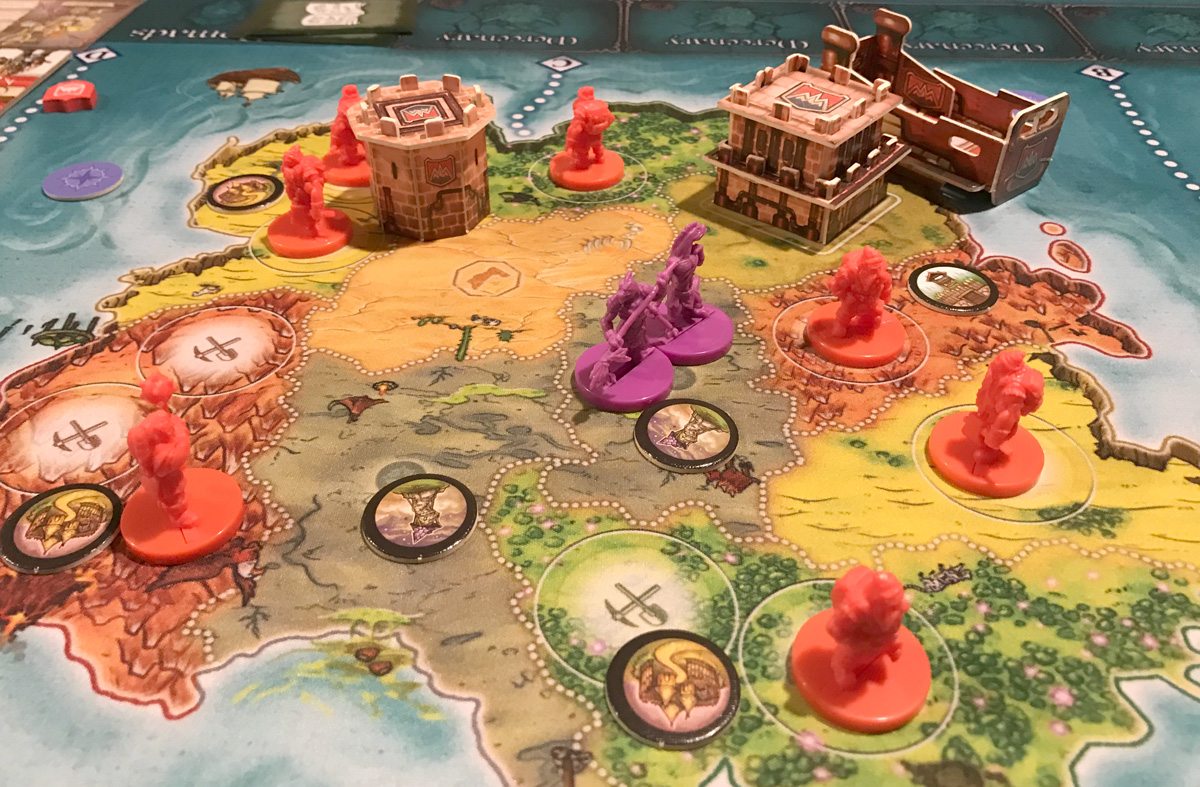
Round End
After each player has taken two actions, the round ends. Each player draws a spell card from the deck (discarding down if necessary). Also, if any of your scribed spells are not ready, turn it 90°; it takes two rounds for a spell to recharge so you can cast it again.
Finally, players get to collect resources—green forests produce mana, red mountains produce ore, and yellow plains produce food. Swamps, deserts, and your capital city region do not produce anything. You collect one resource for each terrain that you occupy. In addition, each tower will collect 2 bonus resources from its terrain, and each serf that is standing in a worker circle collects 1 bonus resource from its terrain. (Warriors and heroes typically do not stand in the worker circles—they’re too busy looking menacing.)
The first player marker is passed clockwise, and all players clear their action spaces and begin a new round.
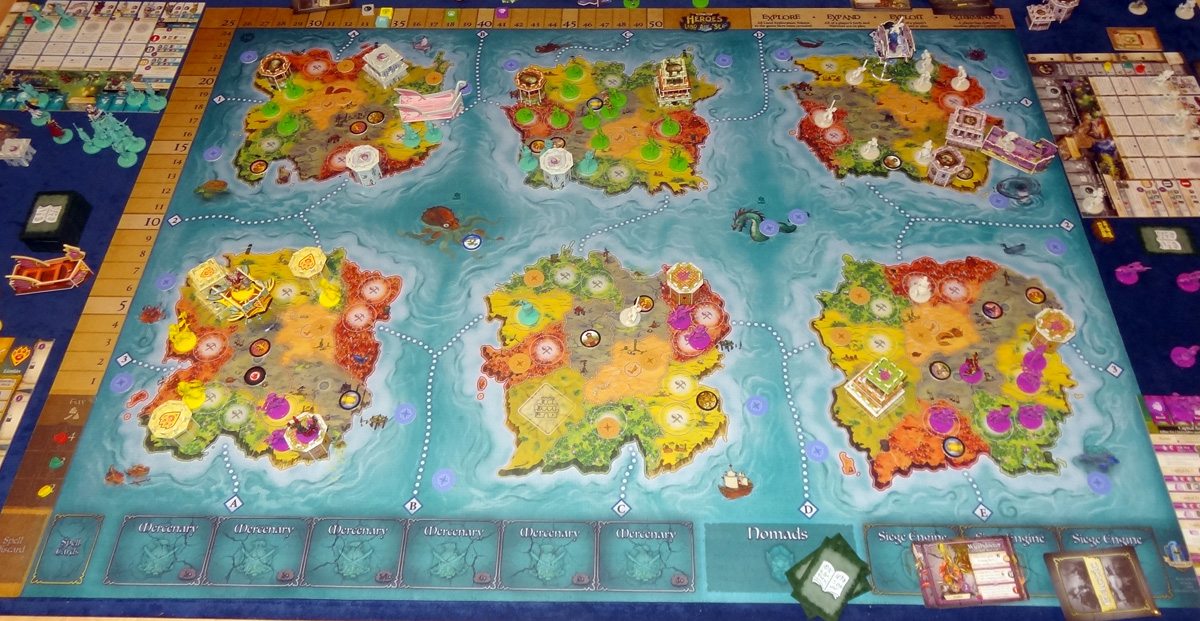
Game End
The game end can be triggered in four different ways.
- Explore: All of the exploration tokens have been revealed.
- Expand: A player has recruited all of their serfs and warriors.
- Exploit: A player has built all three of their towers.
- Exterminate: A player has defeated another player’s capital city.
If any of these happen, you finish the round and play one more round. If “Exterminate” is triggered in a two-player game, the game ends immediately since the defeated player is eliminated.
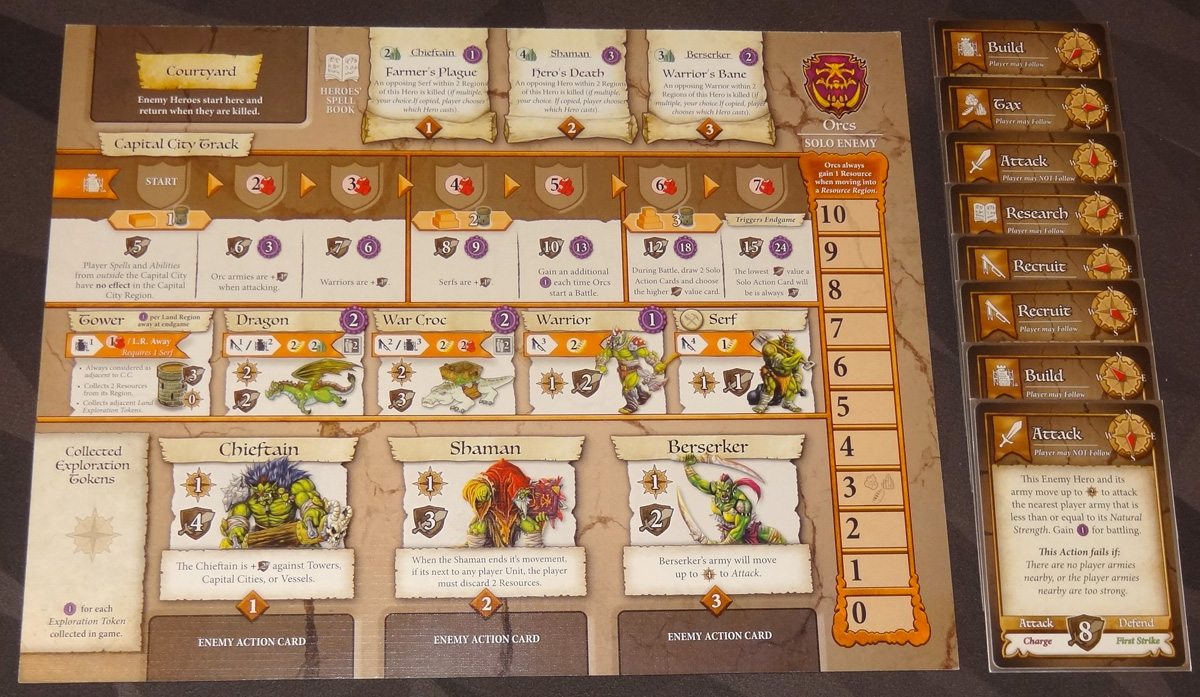
Solo Rules
Heroes of Land, Air & Sea also comes with solo rules, but I’ll save those for a separate post soon!
Why You Should Play Heroes of Land, Air & Sea
Scott Almes and Gamelyn Games have built a solid fan base with their Tiny Epic games, and it seems that a lot of them were willing to take a chance on their first decidedly non-tiny game, and they’re in for a treat. Heroes of Land, Air & Sea is a massive, sprawling game that looks fabulous and gives you so much to explore. (And expand, exploit, and exterminate, of course.) Freed of the constraints of “tiny,” Almes and Gamelyn have basically reclaimed all of the shelf space they’ve saved you in one fell swoop.
The components are so much fun, and if you can splurge for the playmat (and have room for it on your table), I highly recommend it because it’s just so nice to use. The various faction powers and heroes give you many strategies to pursue, and I like that the rules are easy enough to learn that I can play both with my kids and with adults.
My gripe from my original Kickstarter alert still stands: I still feel the title is a bit clunky: Heroes of Land, Air & Sea doesn’t exactly roll off the tongue, and with its thematic and mechanic ties to Tiny Epic Kingdoms, I think it really could have done well as Massive Epic Kingdoms or something along those lines. I started calling it “HOLAS” with my friends and kids, and that may be the name that sticks for us, but I still have to say the entire name when speaking to somebody who doesn’t know what I’m talking about.
The thematic ties to Tiny Epic Kingdom are kind of cool, and I think fans of TEK will like the way some concepts carry over. For instance, the three resources (and the associated regions where you collect them) are the same, and the factions have different abilities that will seem somewhat familiar. But HOLAS expands on those significantly. Your faction now has three unique heroes, vessels that can carry units, and five different buildings. I like the way that upgrading your capital city adds new abilities to just about everything: heroes, vessels, and buildings all gain new abilities every time you upgrade—and some of those abilities even affect serfs and warriors. While it can feel a little overwhelming looking at your faction board and trying to figure out what to do first, I like that it allows for different paths to victory—the trick is figuring out how best to use your faction’s strengths.
Despite some similarities, though, HOLAS isn’t really a replacement for TEK, nor is it redundant to have both. Tiny Epic Kingdoms is kind of like a bird’s-eye-view 4X game, and Heroes of Land, Air & Sea zooms in and gives you a lot more details to play with.
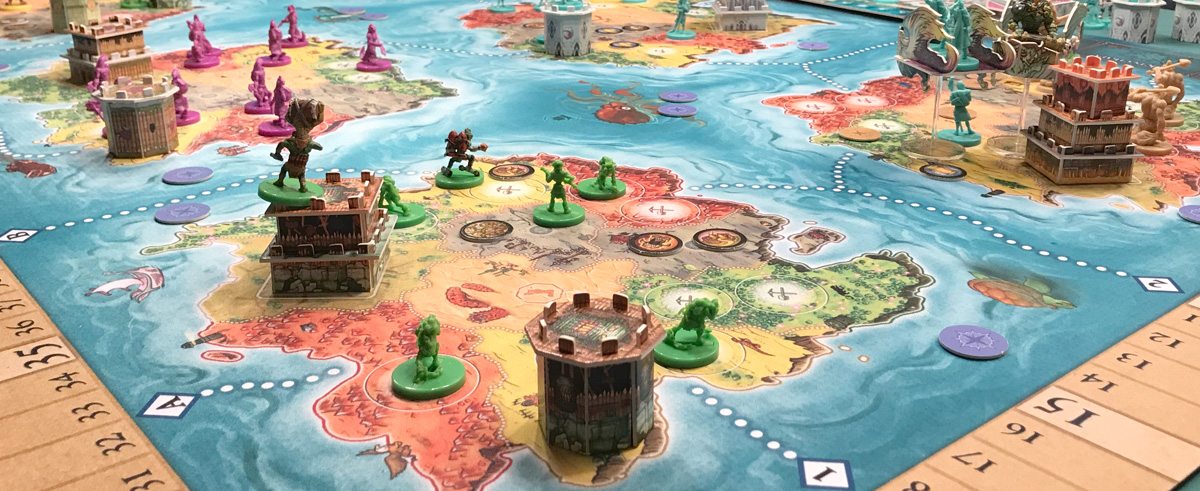
Because of the sheer number of moving parts, HOLAS is substantially more complex than TEK, though primarily because of all the unique abilities to learn. Each player has access to the same set of actions, but the process of selecting actions, following, and mustering is new. The flow of the game is fairly easy to learn after a round or two—however, those prone to analysis paralysis may spend a long time taking a turn because there are so many things to choose from. Fortunately, the game does limit some of your options at the beginning: you can’t fly or sail until you get those vessels; you can’t get those vessels until you have the appropriate buildings; you can’t build those buildings until you collect some more ore because you only start with 2. The first round or two, your available actions will be somewhat limited and most players will do similar things, but as you get your units onto the map and collect resources, strategies will quickly diverge as everyone takes different approaches.
Depending on the player count, combat may or may not be inevitable. For 2, 3, and 5 players, there will be an extra continent that doesn’t have a capital city on it, so there is a little more room for expansion before things get crowded. It might be possible to maintain an uneasy truce in those games. For 4 or 6 players, though, every continent is occupied right from the start, and it’s much more likely that players will run into each other on their quest for more resources or lands to build towers.
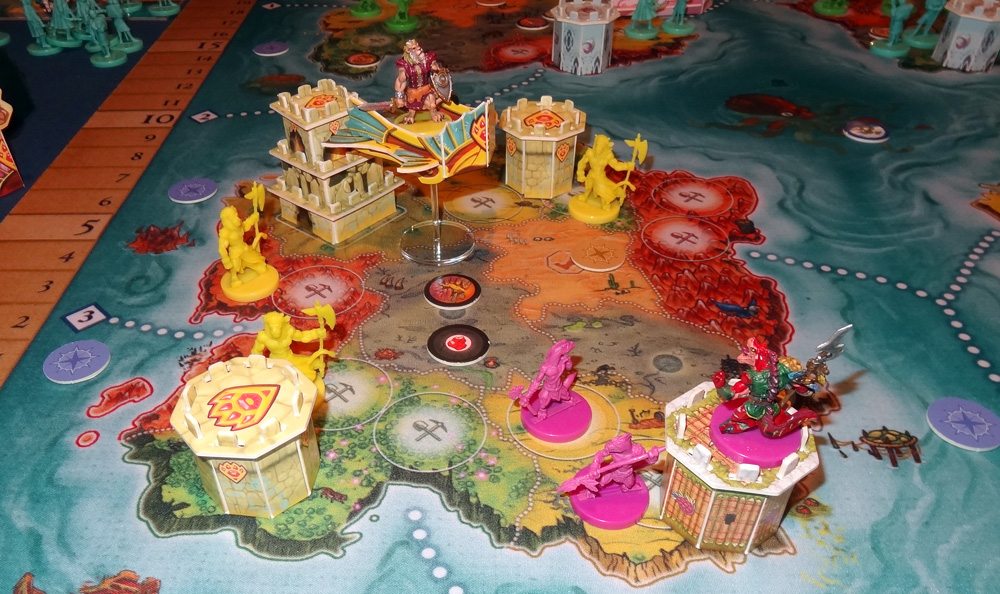
I really like the way the combat system works, and the fact that it isn’t really luck-based. Instead, you choose which tactic card you want to play, based on the resources available to you and what you think your opponent may play. It’s all about reading your opponent and figuring out what they’re likely to do. I like the way you can sometimes overcome a stronger army if you play your cards right, and the way that you can get points for battling even if you lose a fight. Sometimes, even if defeat is inevitable, it may still be worth spending resources on a card that scores you a couple of points, because scores can be tight at the end of the game.
The magic spells also add to that—if you take the research action and make sure you have spells in hand, you may be able to cast fireballs to damage units or add to your own army’s strength before a fight begins. And then there are also other abilities gained through specific buildings or units. For instance, the orc dragon, their air vessel, can eat an enemy unit before battle begins if the capital city has been built up enough. Suffice to say that if extermination is a key part of your strategy, you’ll want to focus on the upgrades that help you fight.
Upgrading your capital city is expensive but generally worth doing, because of the way it upgrades everything you have. You get a bigger hand size for spells, you can build more towers, and all of your existing buildings gain new abilities. I suppose it is possible for somebody to focus on breadth rather than upgrading the capital city, but I’m not yet convinced that you could win with that tactic. On the other hand, just building up your capital city isn’t enough: if you have no buildings, you aren’t making the most of the abilities that could be unlocked.

Even as long as the game is, the end-game triggers often come sooner than expected. Many players recruit serfs aggressively early in the game because they provide more resources when harvesting or potential extra actions by following and mustering. But if you’ve recruited all of your serfs, you’re only four warriors from triggering the end game. Likewise, many players like to spread out on their continents in order to build up resources–if all the land exploration tokens are revealed, the game will end soon. Most of the games I’ve played have ended with the first three Xs, because taking on somebody’s capital city for the Exterminate game-end trigger can be quite difficult.
Because of the different game-end triggers, it is also possible to rush the end if you think you’re head, at least to some extent. You can continue recruiting (and not fighting), and if nobody notices that you don’t have many more units left in your supply, you can surprise them while they’re still working on a long-term strategy.
I’ve played Heroes of Land, Air & Sea several times since receiving the advance copies, and I’ve experienced all the different player counts (except solo). I think it scales well, though of course playing at 6 players does make for a very long game, particularly when everyone is learning the rules. That said, I love playing a 6-player game because of how crowded it gets and because there are so many different factions in play. Aside from hosting several times at home, I’ve even schlepped the whole thing—expansion and playmat and all—to other game nights twice so far just so I could share it with more friends.
I’ve also gotten to try out most of the different factions or at least seen them in action, and it’s been fun to see all their different strengths. The core set factions may be a little easier to play at first:
- Humans: Good on plains, getting food, recruiting.
- Elves: Good on forests, getting mana, casting spells.
- Dwarves: Good on mountains, getting ore, building.
- Orcs: Good at attacking.
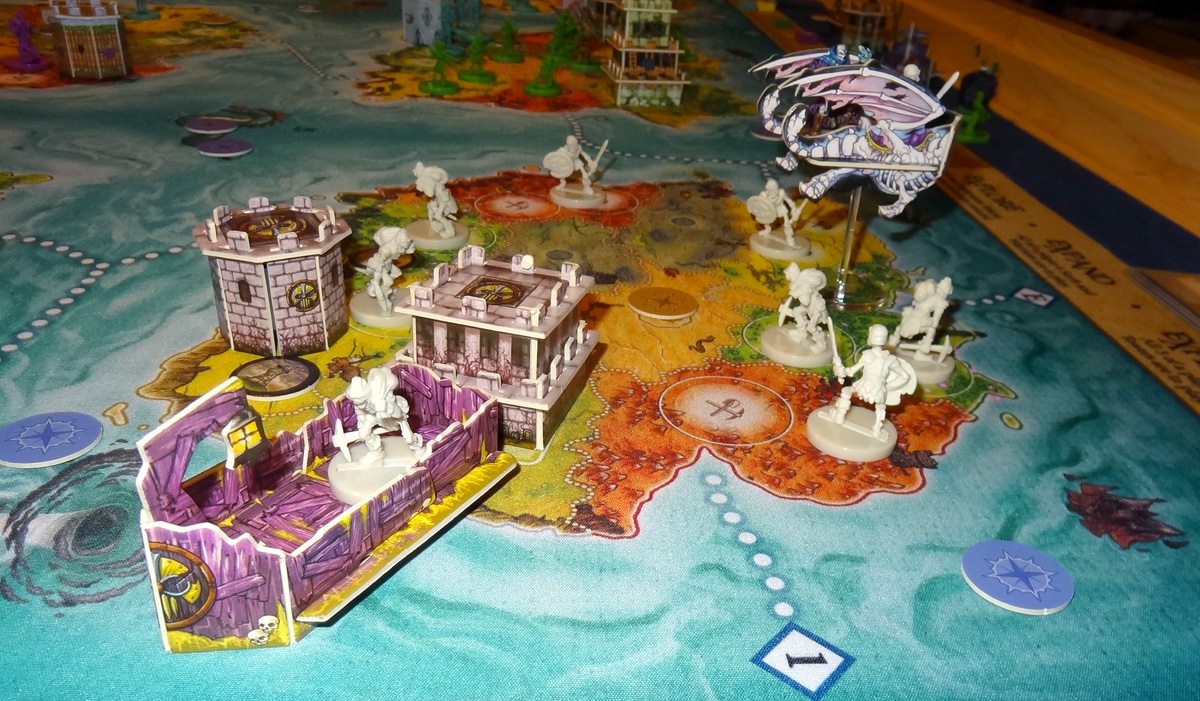
The expansion factions have two that excel at the other types of terrain, and two that I’m still figuring out:
- Lionkin: Good on deserts, and recruiting warriors.
- Lizardfolk: Good on swamps, and spellcasting.
- Goblins: Plentiful and expendable, can blow things up (including themselves).
- Undead: Can harvest souls and have benefits from losing battles.
Of the factions, I think the undead may be the trickiest to figure out, and I haven’t seen an Undead player win yet, but I think it’s probably because of the steep learning curve. The goblins are also tricky, but a lot of fun–they can get abilities to march their towers around and blow them up. If you’re just getting started, the core set definitely has enough to explore for a while, and if you usually play with up to 4 players (or you want to limit the length of the games), that’s probably a good place to start. The Order & Chaos expansion does have some really fun factions to play, though, so it’s hard not to recommend those as well. I suppose it may have been nice to have Order & Chaos be a full stand-alone set as well, but that does add another $20 for people who own both.
Because of the size and expense, I know that Heroes of Land, Air & Sea isn’t for everyone. It’s long, and it takes up a huge amount of space (both on the table and on your shelf). But if you like 4X games and fantasy settings, it’s a blast to play. It may seem strange to call a game that takes hours to play “accessible,” but I do feel that Heroes of Land, Air & Sea just might be the sort of game that draws new players into the 4X genre. I’ve enjoyed it every time, win or lose, and I’m eager to play it again. I haven’t yet tried out the mini-expansions, but I’ll report back on those when I do!
For more info or to pre-order a copy, visit Gamelyn Games.
Click here to see all our tabletop game reviews.
If you’d like to stay up-to-date with all of our tabletop gaming coverage, please copy this link and add it to your RSS reader.
Disclosure: GeekDad received a copy of this game for review purposes.

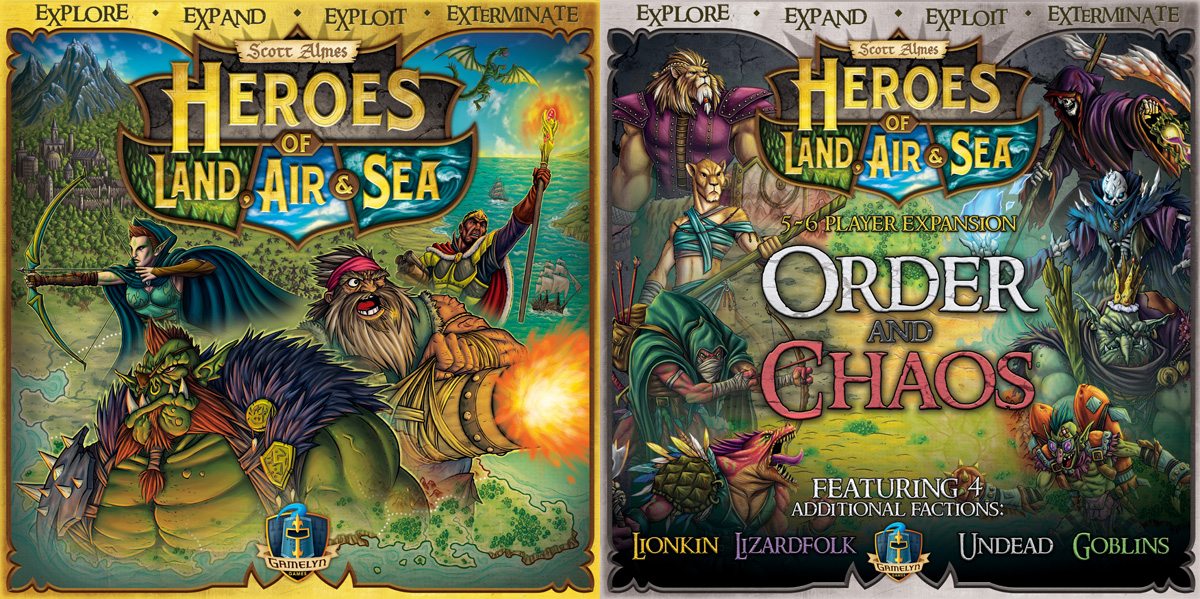
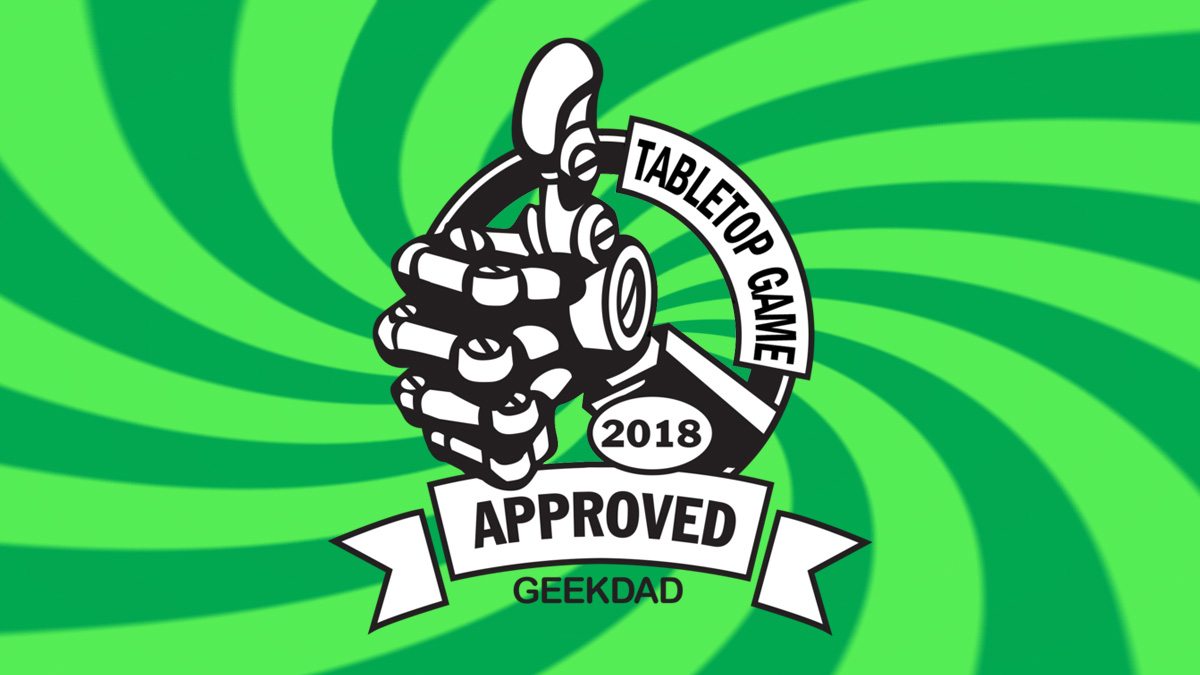



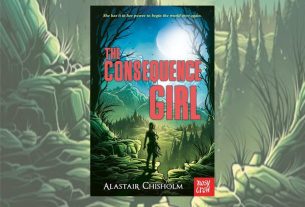

so how is the solo play in this game?
i mainly play it solo bcoz is hard for me to get a group playing..
Hi, Gilbert!
I apologize: I actually haven’t gotten to the solo play on this one yet, because I don’t do much solo play and I’ve had a string of current Kickstarter campaigns to keep up with, but I’m hoping to do a more in-depth dive of the solo play specifically and write that up in a separate article. I’ll come back here and comment on that when I’m able to do that—may be a couple weeks from now, though!